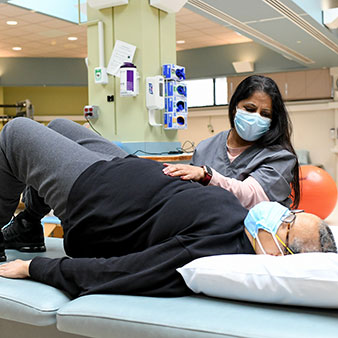Complex Bladder Reconstruction Gave Teresa Her Life Back

October 04, 2022
In June 2021, Teresa Frederico, 60, of Cliffside Park, New Jersey, was surprised to see blood in her urine. It could have been a urinary tract infection, but she did not have any pain or burning. Her daughter Alissa, an oncology nurse at John Theurer Cancer Center, suggested she go to a local emergency room. A CT scan confirmed what Teresa and her husband, Freddie, were shocked to hear: She had a tumor in her bladder.
Teresa saw Michael Stifelman, M.D., chairman of the Urology Department at Hackensack University Medical Center, and urologist Michelle Kim, M.D., who performed a cystoscopy (a procedure to look inside the bladder using a thin camera called a cystoscope) to examine the bladder and look at the tumor.
A week later, Dr. Kim performed removal and biopsy of the tumor cystoscopically. The diagnosis was not good: stage 2 muscle-invasive bladder cancer. Teresa’s bladder would need to be taken out. But there was also hope: Teresa was a candidate for a "neobladder," a reconstructed bladder made of her intestinal tissue, which would spare her from needing to wear an external bag to collect urine.
Innovation and a Minimally Invasive Approach
Teresa needed chemotherapy first to kill residual cancer cells, which she received at John Theurer Cancer Center from June until September under the direction of medical oncologist Robert Alter, M.D. She regained her strength to prepare for bladder removal surgery (cystectomy), which Dr. Stifelman and urologist Mutahar Ahmed, M.D. performed in November 2021 using a single-port robotic approach.
In this innovative method, all of the tools of the robotic surgical system are passed through a solitary 1-inch incision just below the patient’s belly button. Hackensack University Medical Center was among the first seven hospitals in the country to acquire the robotic single-port surgical system in February 2019. Today, 20 percent of the country’s single-port robotic procedures are completed at Hackensack.
“The single-port technology is transformative and enables our surgeons to perform the most complex surgeries in the hardest to reach places, through just one small incision," Dr. Stifelman says.
Benefits of minimally invasive robotic surgery may include:
- Increased precision, as the robot offers greater flexibility, stability and range of motion than a human hand
- Decreased blood loss and reduced need for transfusions
- Less risk of infection
- Less pain after surgery
- Smaller external scars
- Shorter hospital stay
- Faster recovery and return to normal activities
Second Chance at Life
The surgeons removed Teresa’s bladder, then fashioned a neobladder from a single long segment of her small intestine, connecting it to her kidneys and urethra. "This is the most complex urologic surgery. To my knowledge, no one in the country is doing it using the single-port technique, and we completed it in less than five hours," says Dr. Ahmed. "This is an excellent option for patients who are concerned about their appearance after the procedure and for those wishing to return to their active lives quickly."
Teresa went home after five days with a urinary catheter that she used for six weeks, until she had healed enough to put her new bladder to the test. At the moment of truth, she was delighted to learn that it worked just fine. "I was so grateful I didn’t need the bag and that this could all be done through one little incision," she says. "Now when I look at myself in the mirror, I can’t even tell that the surgery was done. I still look like me."
She sometimes experiences occasional bladder leaks, but that should improve over time.
By April 2022, she was well enough to throw a bridal shower for her daughter Alessandra and to enjoy the wedding the following June. "I danced the whole night away," Teresa says. "I am so grateful for the second chance at life that I got from the doctors and nurses at Hackensack. Everyone was so knowledgeable, understanding and compassionate. Dr. Ahmed is the surgeon with the hands of gold."
Next Steps & Resources:
- Meet our sources: Mutahar Ahmed, M.D., and Michael Stifelman, M.D.
- To make an appointment with a urology specialist near you, call 800-822-8905 or visit our website.
- Learn more about robotic urology surgery
The material provided through HealthU is intended to be used as general information only and should not replace the advice of your physician. Always consult your physician for individual care.

Signs of Bladder Issues
Bladder problems can disrupt our day-to-day life, and as we get older, they’re more likely to occur.

Retired Science Teacher Relies on Former Student When Faced With Bladder Cancer
Retired teacher Peter Kahan benefited from cutting-edge bladder cancer treatment—thanks to his former student, now a urologic oncologist.

Fighting Bladder Cancer
The fears of Rose Ann Rangel, whose mother and brother died of cancer, seemed to be coming true.

Do You Feel Like Your Bladder Is Dropping?
Pelvic organ prolapse - a condition where the muscles in the pelvis can no longer support the pelvic organs - affects almost half at some point in their lives.

Should Women See a Urologist?
Urologists treat all sorts of urinary tract problems in both men and women.

6 Reasons You May Need Pelvic Floor Rehab
The pelvic floor is a group of skeletal muscles in the base of your torso that are responsible for bowel and bladder function and sexual pleasure.